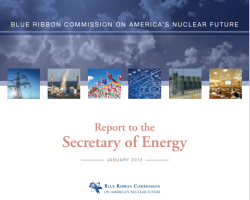Category of Content
Siting Experience Documents Only
Publication Date
Subject Matter
Country
Keywords
Managing Commercial High-Level Radioactive Waste
Managing Commercial High-Level Radioactive Waste
After more than 20 years of commercial nuclear power, the Federal Government has yet to develop a broadly supported policy for fulfilling its legal responsibility for the final isolation of high-level radioactive waste. OTA's study concludes that until such a policy is adopted in law, there is a substantial risk that the false starts, shifts of policy, and fluctuating support that have plagued the final isolation program in the past will continue.
Legal Analysis of Commission Recommendations for Near-Term Actions
Legal Analysis of Commission Recommendations for Near-Term Actions
At the request of the staff to the Blue Ribbon Commission on America’s Nuclear Future (“BRC”), we have reviewed whether certain recommendations in the BRC’s July 29, 2011 Draft Report respecting near-term actions by the Department of Energy (“DOE”) or other officers or agencies in the Executive Branch can be implemented under existing law. These recommendations relate to:
(1) Initial steps to site, license and construct consolidated interim storage facilities for spent nuclear fuel (“spent fuel”);
THE ROLE OF INDIAN TRIBES IN AMERICA’S NUCLEAR FUTURE
THE ROLE OF INDIAN TRIBES IN AMERICA’S NUCLEAR FUTURE
Indian tribes have voiced their tribal issues in the United States‘ nuclear effort since its
inception, with the siting of what would become Los Alamos National Laboratory adjacent to the
San Ildefonso Pueblo Reservation and the Hanford plutonium production works along waterways
shared with the Yakama Nation and other Indian tribes. The siting of a proposed repository at
Yucca Mountain, Nevada along with other activities conducted on the Nevada National Security
Site (NNSS) (formerly the Nevada Test Site), increased the need for the United States
Blue Ribbon Commission on America’s Nuclear Future Draft Report to the Secretary of Energy
Blue Ribbon Commission on America’s Nuclear Future Draft Report to the Secretary of Energy
America’s nuclear waste management program is at an impasse. The Obama Administration’s decision
to halt work on a repository at Yucca Mountain in Nevada is but the latest indicator of a policy that has
been troubled for decades and has now all but completely broken down. The approach laid out under
the 1987 Amendments to the Nuclear Waste Policy Act (NWPA)—which tied the entire U.S. high-level
waste management program to the fate of the Yucca Mountain site—has not worked to produce a
Legal Background and Questions Concerning the Federal Government’s Contractual Obligations Under the “Standard Contracts” with “Utilities”
Legal Background and Questions Concerning the Federal Government’s Contractual Obligations Under the “Standard Contracts” with “Utilities”
This Memorandum analyzes issues related to the Standard Contract between the U.S. Department of Energy (“DOE”) and the “utilities.” Beginning with a discussion of specific provisions of the Standard Contract, this Memorandum then analyzes the status of lawsuits involving the Standard Contract, reviews issues related to on-site storage of spent fuel and HLW, and assesses the prospects for modifying the current waste-disposal regime through Federal legislation or amendments to the Standard Contract.
Attachment 1 - Memo, Reply to Letter to Mr. Tim Frazier
Attachment 1 - Memo, Reply to Letter to Mr. Tim Frazier
This memo sets forth the Office of Standard Contract Management's current estimate of the US Government's liability in connection with the Government's partial breach of the "standard contracts" that it executed pursuant to the NWPA of 1982. The Office of Standard Contract Management estimates that liability, as of today and based on the analysis and qualifications set forth below, to be $15.4 billion.
...
Deciding for the Future: Balancing Risks, Costs, and Benefits, Fairly Across Generations
Deciding for the Future: Balancing Risks, Costs, and Benefits, Fairly Across Generations
The key challenge of this National Academy of Public Administration project is captured in the subtitle of this report, Balancing Risks, Costs, and Benefits Fairly Across Generations.
Enhancing the Role of State and Local Governments in America’s Nuclear Future: An Idea Whose Time Has Come
Enhancing the Role of State and Local Governments in America’s Nuclear Future: An Idea Whose Time Has Come
This paper, prepared to aid the Blue Ribbon Commission on America’s Nuclear Future in its
deliberations, includes a discussion of the issues that would be faced in the siting, permitting and
licensing of storage and disposal facilities for the “back end” of the commercial nuclear fuel
cycle and for the Department of Energy’s (DOE) high–level radioactive waste. It discusses the
authority that could be employed by non–federal levels of government in supporting or opposing
Blue Ribbon Commission on America’s Nuclear Future Report to the Secretary of Energy
Blue Ribbon Commission on America’s Nuclear Future Report to the Secretary of Energy
This report highlights the findings and conclusions of the Blue Ribbon Commission on America’s Nuclear Future (BRC) and presents recommendations for consideration by the Administration and Congress, as well as interested state, tribal and local governments, other stakeholders, and the public.
Enhancing the Role of State and Local Governments in America's Nuclear Future: An Idea Whose Time Has Come
Enhancing the Role of State and Local Governments in America's Nuclear Future: An Idea Whose Time Has Come
The Blue Ribbon Commission on America's Nuclear Future was formed by the Secretary of<br/>Energy at the direction of the President. The Commission was formed to conduct a<br/>comprehensive review of policies for managing the back end of the nuclear fuel cycle, including<br/>all alternatives for the storage, processing, and disposal of civilian and defense used nuclear fuel,<br/>high–level waste, and materials derived from nuclear activities.


